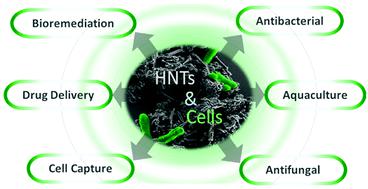Our official English website, www.x-mol.net, welcomes your feedback! (Note: you will need to create a separate account there.)
Halloysite nanotubes – the nano-bio interface
Nanoscale ( IF 6.7 ) Pub Date : 2020-11-25 , DOI: 10.1039/d0nr06820a Ofer Prinz Setter 1, 2, 3, 4 , Ester Segal 1, 2, 3, 4
Nanoscale ( IF 6.7 ) Pub Date : 2020-11-25 , DOI: 10.1039/d0nr06820a Ofer Prinz Setter 1, 2, 3, 4 , Ester Segal 1, 2, 3, 4
Affiliation

|
The numerous biological applications of nanoparticles in general and nano-clays in particular are rooted in understanding and harnessing their dynamic nano-bio interface. Among clays, the intrinsically-mesoporous halloysite nanotubes (HNTs) have emerged in recent years as promising nanomaterials. The diverse interactions of these nanotubes with living cells, encompassing electrostatic, van der Waals, and ion exchange, along with cellular response, are crucial in determining the behaviour of HNTs in biological systems. Thus, rational engineering of the nanotube properties allows for vast applications ranging from bacteria encapsulation for bioremediation, through algae flocculation for aquaculture, to intracellular drug delivery. This review summarizes the many aspects of the nano-bio interface of HNTs with different cell types (bacteria, algae and fungi, and mammalian cells), highlighting biocompatibility/bio-adverse properties, interaction mechanisms, and the latest cutting-edge technologies.
中文翻译:

埃洛石纳米管–纳米生物界面
纳米粒子在一般的纳米粒子中的众多生物学应用,尤其是纳米粘土,都植根于对纳米粒子动态生物界面的理解和利用。在粘土中,近年来内在介孔的埃洛石纳米管(HNT)成为有前途的纳米材料。这些纳米管与活细胞的各种相互作用,包括静电,范德华力和离子交换,以及细胞反应,对于确定HNT在生物系统中的行为至关重要。因此,合理设计纳米管的性能可实现广泛的应用,从用于生物修复的细菌封装,通过用于水产养殖的藻类絮凝到细胞内药物传递。这篇综述总结了HNTs与不同细胞类型(细菌,细菌,细菌,
更新日期:2020-11-25
中文翻译:

埃洛石纳米管–纳米生物界面
纳米粒子在一般的纳米粒子中的众多生物学应用,尤其是纳米粘土,都植根于对纳米粒子动态生物界面的理解和利用。在粘土中,近年来内在介孔的埃洛石纳米管(HNT)成为有前途的纳米材料。这些纳米管与活细胞的各种相互作用,包括静电,范德华力和离子交换,以及细胞反应,对于确定HNT在生物系统中的行为至关重要。因此,合理设计纳米管的性能可实现广泛的应用,从用于生物修复的细菌封装,通过用于水产养殖的藻类絮凝到细胞内药物传递。这篇综述总结了HNTs与不同细胞类型(细菌,细菌,细菌,


























 京公网安备 11010802027423号
京公网安备 11010802027423号